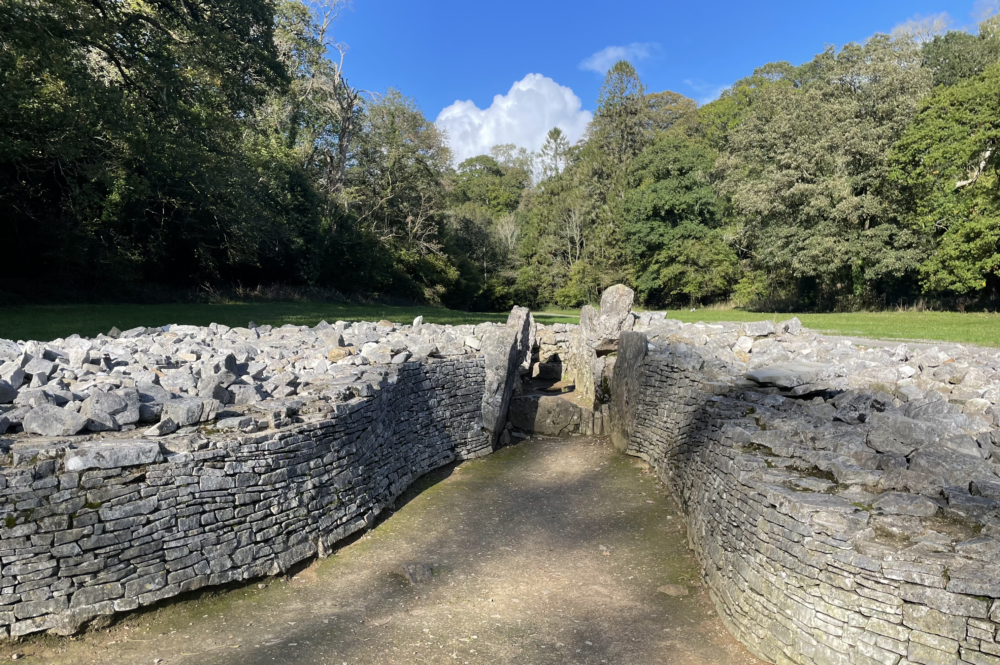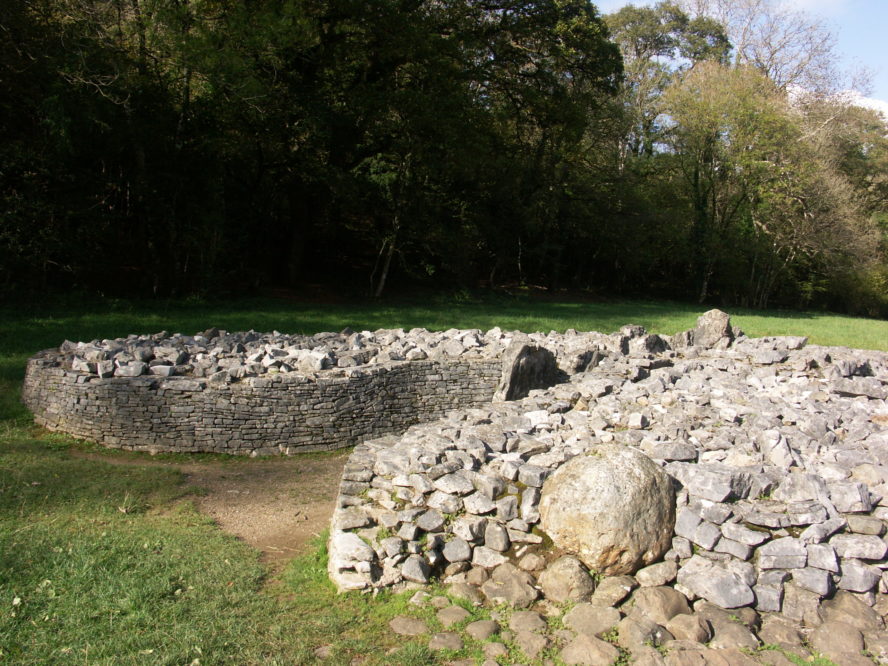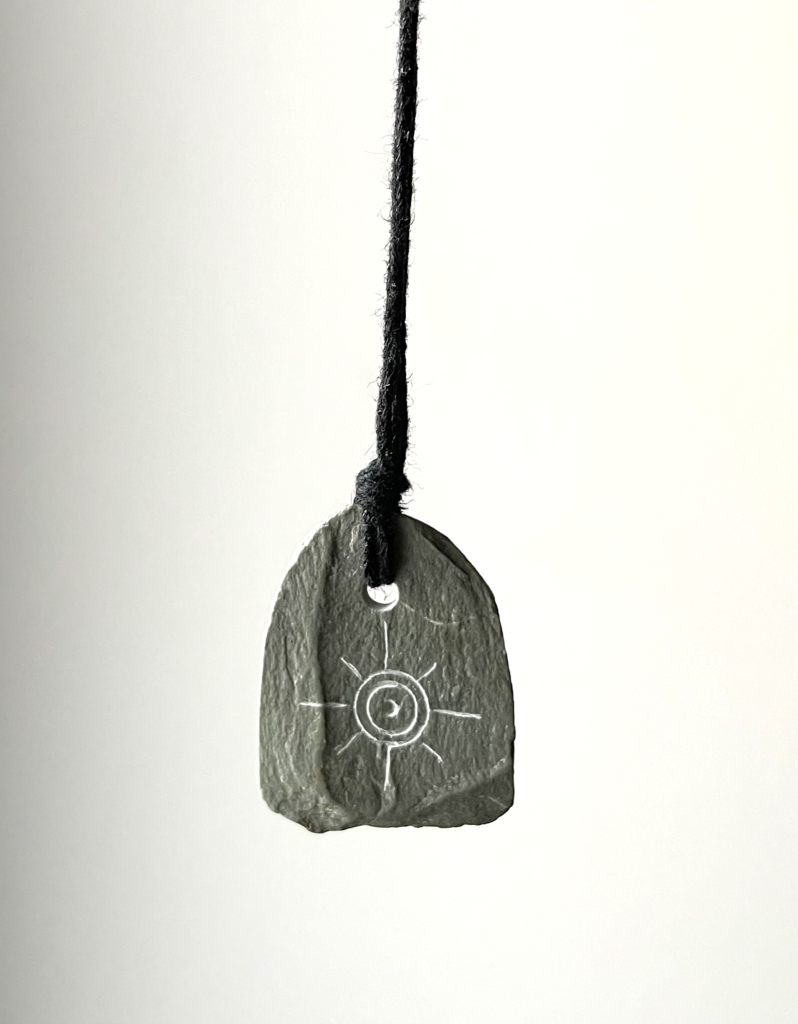Letter from Parc Le Breos

Tess Powell
There I stood, and there it squatted: the 6,000 year old burial chamber at Parc Le Breos.
It was a fifteen minute walk up the road from Shepherd’s; a little area in Gower just off the A4118 where you can find an eclectic array of charming businesses: a cafe, bakery, general store, the world’s smallest cinema, and at the head of the triangular offshoot, the Gower Heritage Centre.
I know it’s a normal everyday occurrence for people here to walk on by ancient structures and not think twice of it, (in fact it seemed that everyone at Parc Le Breos that day was just there to walk their dog) but I’m new to the area – new to the country in fact- and was rather intrigued so I thought to myself, ‘well let’s go see this thing.’
The burial chamber is a large, low to the ground structure which was excavated first in 1869 and later 1960, where the remains of forty humans were found. The Neolithic people would have waited for their loved ones’ bodies to decompose, likely in caves, and then later move their bones to the chambers. The bones have of course, have since been removed, but you can still walk into the thin pathway cut through the shallow walls and peek at where they would have been.
Emotion
The thing is, it’s incredible. It’s incredible that we can look at this thing today that other hands like ours built so so long ago, but I had to admit as I looked at this thing, that my back was starting to hurt very badly, and I was so incredibly tired from just coming out of my second cold in two weeks that all I really wanted was to go sit down somewhere nice and have a cup of tea.
I stared at this mass of sediment and tried to glean something out of it the best I could; thinking that if I stared long and hard enough I’d suddenly be overcome with emotion and somehow mentally sync up with another human being from 6,000 years ago. Nearby in the trees there was group of teens smoking weed.

Old rocks
So here I am in front of an incredibly old and significant historical site and I feel like I’m just looking at a pile of rocks. This has happened to me before at museums, historical landmarks, places of importance. A sort of dull, “huh, well there it is,” type of feeling.
In movies, to highlight something is special it’s accompanied by an orchestral soundtrack, by breathtaking footage, a cut back to the hero’s emotional face. In comparison things feel very lack luster in real life; especially when your back is full of knots and you’re out of breath and your long distance vision isn’t working quite right.
And then I had to wonder, if piles and piles of dirt suddenly covered Shepards like a second coming of Pompeii; and it was discovered, excavated thousands of years later, and put on display beside a walking path for all to see, what meaning would the tired, back-pain-ridden person glean from my pile of bones, from the ruins of those buildings.
Maybe it’s better to think about what meaning it all could have now.
In those days it would have been just a normal part of your life, a visit to the bone pit. A neolithic human brought back to life now would perhaps also look at this thing, shrug and say, “Yeah that’s where we put good old Org after he died.”
Unbelievably old
At the Heritage Centre I talked to a person named Sami who gave me information on the area as well as talking about his ancient jewelry making workshops. He creates paleolithic jewelry using the same techniques that would have been used in prehistory. For reference, the Paleolithic era is the unbelievably old stone age period and the Neolithic era is the slightly less unbelievably old stone age period.
He then showed me one of his pieces: a carved bone strung on leather. Something about that felt so alive and fascinating. It recontextualizes something that would otherwise seem very alien. Here are my hands, now, making something that similar hands would have made then, in the same way with the same tools.
Suddenly it isn’t so hard to mentally connect with another human being thousands and thousands of years ago, and you don’t need the orchestra playing to feel something.
I’d return to the Gower Heritage Centre the following Saturday to attend one of these workshops myself, though it was quite the hectic day to choose since the Cider Festival was going on at the same time.
The outside area was milling with activity that smelled strongly of apples. A Ukrainian folk dancing troupe in bright ripe red skirts and flower adorned head pieces collected and chatted, waiting to perform on the stage that had been set up inside. Large collections of fruit in crimsons, yellows, and greens waited to be crushed by a 200 year old press.
Two others joined me for the workshop, a mother and her daughter who were very interested and attentive and I never did ask them why they decided Paleolithic jewelry making would be their Saturday activity but I didn’t really want to sound accusatory, “I know why I’m here with my weird reasons, what are your weird reasons?”
Labyrinthal
The four of us sat at an old wooden table in one of the display rooms. The Heritage Centre is a labyrinthal little museum that details the history of the region and the on-site flour mill as well as many other things.
It has a blacksmithing shop, an old woolen mill, a tea house, and the most terrifying display mannequins almost purposefully set up to make you jump as you round a corner and see them standing next to caskets of all things, caskets they possibly will come to life and put you in.
Spinning
Sami laid out many small flat pieces of stone that we got to choose from, and then explained the hole drilling process of which there are many methods. One just involves using a sharp piece of flint and boring a hole very patiently with your hand. Then there are more advanced hand drills; these are fat sticks that have a sharpened metal end, others have a cylindrical wooden weight placed at the bottom. You take them between your hands and rub in the same way you would to start a fire.
Then there are bow drills and pump drills, drills wrapped with twine that use the physics of winding and unwinding to continue spinning. I remarked that many of these looked exactly like my drop spindle, which is used to add twist to fiber and create yarn.
As it turns out if you want a stick to spin well, adding a circular weight to it does just the trick; and our ancestors had discovered it so long ago I don’t even want to think about it.
One of the drills is a design from New Zealand and is called a tūwiri in Te Aka Māori. Tūwiri means, as a noun, drill, but as a verb ‘to tremble’ or ‘to be afraid.’ Sami guessed that the word might be an onomatopoeia, that the action of turning and twisting, especially into wood would have a sound a lot like ‘tuwiriririri.’

Drilling
Welsh has some similar sounding words for “bore” such as tyllu “bore, burrow”, tyllwr “borer, punch”, turio “burrow, bore, root.”
Who knows, perhaps these words could all come from the same place; from somewhere much much older, when early humans were one group, all spending a lot of their time with rocks and sticks and having fun drilling holes into things; singing to the tune of their tools, making up sounds that’ll become words that’ll trickle down forever.
Before I knew it I’d drilled a perfect hole through my little stone. Never in my life would I think I’d manage that but here I am doing it without the help of complex machinery.
And once you’ve got your hole in your rock you can decorate it however you like, though there are some common ancient designs that you can choose to use, one being repetitive circles like a bullseye which have been found on many excavated pieces.
At the table with me the mother and her daughter carved into their stones with flint and metal tools. Outside down the walkway there was a bluegrass band playing ‘Country Roads’ and people drinking all types of perry and ciders of varying alcoholic content.
I bet a stone age human would’ve had a great time at that event. Re-fitted to match their time period I mean, otherwise they’d probably just stand in the corner screaming. But a gathering full of other people, playing music, eating and drinking things, doing crafts and dancing, humans from any thousands of years ago would be able to enjoy that.
Should I wait for the bodies of my loved ones to decompose in a cave before taking their bones and putting them in a stone covered pit in order to fully appreciate what the neolithic people had going on? Maybe. I’d have to ask my mom how she feels about that.
But I think I can say I’m justified with my feelings of preferring to experience human connection over viewing human antiquity. In the end we are all living ancient history.
Support our Nation today
For the price of a cup of coffee a month you can help us create an independent, not-for-profit, national news service for the people of Wales, by the people of Wales.







Superb post! I really enjoyed reading it and looking forward to your next post. Thanks for sharing.